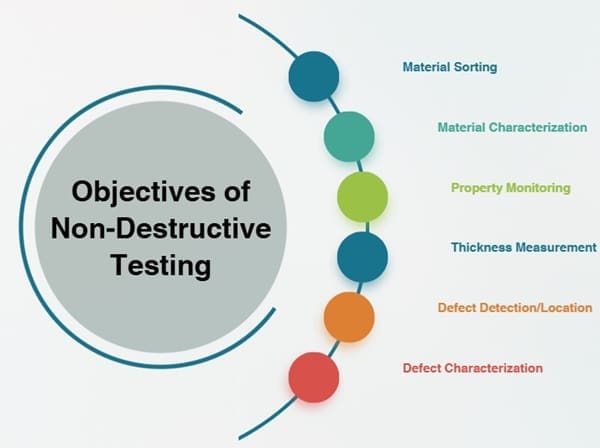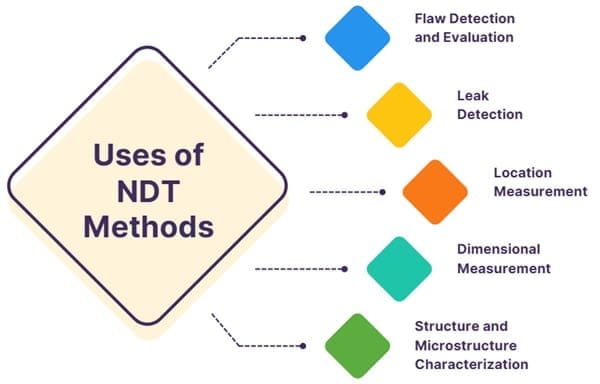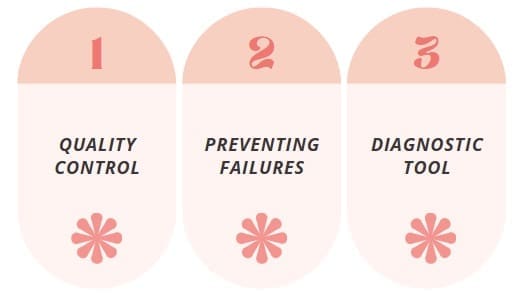Non-destructive testing (NDT) examines materials, components, or structures for defects without causing any damage. These techniques identify flaws or irregularities while maintaining the integrity of the object being tested.
NDT plays a crucial role in maintaining safety, quality control, and reliability in industries such as manufacturing, aerospace, and construction.
Table of contents
Introduction to Non-Destructive Testing
Materials, regardless of how carefully they are manufactured, can have flaws or defects. These flaws often result from imperfections in their crystal structure or from manufacturing processes like welding, casting, or forging.
Additionally, stress, corrosion, or fatigue expose materials to further damage during their service life.Identifying these flaws is critical because undetected defects can lead to failure, potentially causing accidents, injuries, or even loss of life.
Non-destructive testing (NDT) allows engineers and technicians to detect and evaluate these flaws without damaging the material. By using various testing methods, it is possible to identify the location, size, and nature of defects in materials, components, or structures.
Once someone identifies these flaws, decision-makers can decide whether to repair the component, continue its service, or replace it.
What is Non-Destructive Testing (NDT)?
Non-Destructive Testing (NDT) is a crucial technique used to inspect materials or structures without damaging them. This approach plays a crucial role in ensuring the safety and reliability of various systems, such as aircraft, pipelines, reactors, and trains.
NDT primarily aims to identify potential flaws, weaknesses, or material degradation without impacting the future use of the object being tested. In essence, NDT helps detect defects early, preventing catastrophic failures and ensuring cost-effective operations across industries.
Objectives of Non-Destructive Testing

Non-destructive testing has several key objectives that include:
- Material Sorting: Identifying and categorizing materials based on their properties.
- Material Characterization: Understanding the structure and composition of materials.
- Property Monitoring: Monitoring physical properties of materials, especially for process control.
- Thickness Measurement: Measuring the thickness of materials to ensure they meet required standards.
- Defect Detection/Location: Finding defects or discontinuities in materials and identifying their location.
- Defect Characterization: Assessing the type and extent of defects found in materials.
Uses of NDT Methods

NDT is commonly used for the following purposes:
- Flaw Detection and Evaluation: Identifying internal or external defects and evaluating their severity.
- Leak Detection: Locating leaks in systems, pipes, or tanks.
- Location Measurement: Determining the precise location of defects or changes in material properties.
- Dimensional Measurement: Ensuring that the dimensions of materials or components meet specifications.
- Structure and Microstructure Characterization: Analyzing the internal structure of materials, such as grain size or phase composition.
Necessity of Testing
Testing materials before use is crucial for several reasons:
Defect Detection: To find any flaws in the material that may affect its performance.
Property Determination: To assess the chemical, mechanical, and physical properties of the material.
Strength and Hardness: To check the material’s strength, hardness, and resistance to failure.
Material Suitability: To ensure that the material is suitable for its intended purpose.
Advantages of NDT
NDT offers numerous benefits that make it an essential part of quality assurance processes. Some of the major advantages include:
- No Damage to the Specimen: Unlike destructive testing, NDT does not harm or alter the specimen. This is crucial as it allows the material to be reused after testing.
- 100% Testing on Actual Components: NDT allows for testing of entire parts or components without destroying them. This ensures the results are accurate and reflective of the material’s condition.
- In-Service Testing: One of the unique aspects of NDT is that testing can be done while the material or component is in service. This helps detect flaws before they lead to failures, preventing breakdowns.
- Repeated Checks: NDT can be repeated multiple times over an extended period. Regular testing helps reduce the risk of accidents and ensures ongoing safety.
- Rapid Results: NDT techniques are fast, allowing for quick inspection and decision-making. This speed helps to minimize downtime and keep operations running smoothly.
Disadvantages of NDT
Despite its many advantages, NDT has some limitations:
- High Initial Investment: The equipment and technology required for NDT can be expensive. This initial cost may be a barrier for smaller organizations or projects.
- Skilled Personnel Required: NDT requires trained and experienced personnel to conduct tests and interpret the results accurately. A lack of skilled workers can result in incorrect interpretations and unreliable results.
Scope of NDT

The scope of NDT is vast, and it serves several purposes in different industries. Some of its key applications include:
Quality Control: NDT is used during manufacturing or fabrication to ensure that products meet the required specifications and quality standards.
Preventing Failures: NDT helps in monitoring equipment and components in service. Regular testing ensures that failures are detected before they occur, preventing costly repairs and downtime.
Diagnostic Tool: In research and development, NDT is used to assess materials and products. It helps in understanding their behavior under stress and other conditions.
Basic Principles of NDT

Although there are various methods of NDT, all of them share a few common principles. These include:
- Probing Energy: This is the energy or medium used to inspect the material. It can be electromagnetic, ultrasonic, or mechanical, among others.
- Detection of Discontinuities: The method detects any changes in the probing medium caused by defects or discontinuities within the material.
- Indicating and Recording Changes: Once a defect is detected, the changes in the probing energy are recorded and displayed. These changes provide a visual or digital indication of the flaw.
- Interpretation: Skilled technicians interpret the recorded changes to identify and assess the severity of the flaw.
Non-Destructive Evaluation (NDE)
While NDT focuses on detecting flaws, Non-Destructive Evaluation (NDE) goes a step further by quantitatively assessing these defects. NDE not only identifies the location of a flaw but also measures its size, shape, and orientation.
This deeper analysis helps engineers understand the severity of the problem and make informed decisions on how to proceed with repairs or replacements. NDE can also assess material properties like toughness, formability, and other physical characteristics, providing valuable insights into a material’s overall performance.
Although people often use the terms NDT and NDE interchangeably, NDE typically refers to the more detailed analysis of flaws, while NDT generally refers to the overall process of defect detection.
Common NDT Techniques

NDT employs numerous methods to inspect materials and components. Many of these techniques borrow from the medical field, where similar principles examine the human body without causing harm. Some of the most well-known NDT methods include:
- Visual and Optical Testing (VT)
Visual inspection is the simplest form of NDT. It involves the use of the human eye, often aided by magnifying glasses, mirrors, or borescopes, to detect defects such as cracks, corrosion, or oxidation. This method is commonly used in industries like aviation, where more than 80% of inspections are done visually. In nuclear power plants, visual inspections also play a key role in the safety of control rods and fuel elements. It serves as an initial screening technique that directs further testing to areas that need closer examination. - In-Situ Metallography
Industries like power plants and pipelines use in-situ metallography, or field metallography.This method involves grinding and polishing a small area of a metal surface to reveal its microstructure. The goal is to identify flaws like cracks or corrosion that might not be visible on the surface. Special equipment grinds, polishes, and etches the metal surface, followed by microscopic examination to assess the material’s condition.This technique is particularly useful in evaluating the quality of welds and the integrity of metal structures under stress. - Ultrasonic Testing (UT)
In ultrasonic testing, technicians send high-frequency sound waves into a material. The sound waves bounce off the internal structure, and they analyze the resulting echoes to detect flaws. For example, ultrasonic testing can identify cracks or voids within metal components. Industries like aerospace and manufacturing commonly use this method, where materials must meet stringent quality standards. - X-Ray and Radiographic Testing (RT)
X-ray inspection is one of the oldest NDT methods and remains popular in industries like aviation and construction. Technicians pass X-rays through a material and analyze the resulting image to detect internal defects. This technique is particularly effective for detecting issues like weld cracks or voids inside metal components. Radiographic testing allows for a detailed, non-invasive examination of the internal structure of materials, making it ideal for complex inspections. - Magnetic Particle Testing (MT)
Technicians use magnetic particle testing to detect surface and near-surface flaws in ferromagnetic materials. The process involves magnetizing a material and then applying magnetic particles to the surface. Any surface cracks will disrupt the magnetic field, causing the particles to gather at the flaw, making it visible. Inspectors commonly use this method to examine steel components, such as engine parts or structural beams. - Eddy Current Testing (ET)
Eddy current testing uses electromagnetic induction to detect cracks and other defects in conductive materials. This technique is especially useful for detecting surface and sub-surface defects in materials like aluminum, steel, and copper. The aerospace industry often uses eddy current testing to inspect aircraft components, such as fuselage panels and engine parts. - Acoustic Emission Testing (AE)
Acoustic emission testing detects high-frequency sound waves produced by the rapid release of energy from cracks or other defects within a material. This method is particularly useful for monitoring the condition of structures under stress, such as bridges or pressure vessels. Acoustic emission testing can detect active defects that are growing or worsening, allowing for timely intervention and maintenance. - Holographic Nondestructive Testing (HNDT)
Holographic techniques, including optical holography, provide a sophisticated way to detect both surface and subsurface defects in materials. This method involves comparing an object’s surface before and after it undergoes stress, such as mechanical loading or thermal expansion. Holographic testing can detect anomalies in the material’s deformation pattern caused by internal flaws, making it highly effective in applications like aerospace and turbine inspection. With advancements in laser technology and digital imaging, holographic NDT continues to evolve, offering new capabilities for real-time monitoring and automated defect detection.
Final Words
Non-destructive testing is an invaluable tool for ensuring the safety, quality, and longevity of materials and structures in a wide range of industries. While there are limitations to each NDT method, they offer significant advantages in terms of efficiency, cost-effectiveness, and safety.
By selecting the appropriate method for each application, NDT helps detect potential issues early, preventing failures and ensuring that materials continue to perform as expected.

About Six Sigma Development Solutions, Inc.
Six Sigma Development Solutions, Inc. offers onsite, public, and virtual Lean Six Sigma certification training. We are an Accredited Training Organization by the IASSC (International Association of Six Sigma Certification). We offer Lean Six Sigma Green Belt, Black Belt, and Yellow Belt, as well as LEAN certifications.
Book a Call and Let us know how we can help meet your training needs.



















